Analytical Model of the Connection Handoff in 5G Mobile Networks with Call Admission Control Mechanisms
Abstract
1. Introduction
- Firstly, this article presents a generalized model of the limited-availability group that can be used to determine the blocking probability for individual classes of requests offered in 5G systems without CAC mechanisms introduced.
- Secondly, this article describes a model of a limited-availability group with resource reservation mechanisms for blocking probability calculations in 5G systems with reservation mechanisms.
- Then, this article proposes a model of a limited-availability group with threshold mechanisms used for blocking probability calculations in 5G systems.
- Finally, this article presents the algorithm for a blocking probability calculation in the group of cells in 5G systems with CAC mechanisms.
2. Limited-Availability Group
2.1. Generalized Model of the Limited-Availability Group with Erlang Traffic Streams
2.2. Structure of Offered Traffic
2.3. Blocking Probability Calculations
3. Limited-Availability Group with CAC Mechanisms
3.1. Resource Reservation Mechanism
- Determination of values of the offered traffic according to (3).
- Calculation of the values of the total conditional passing coefficients based on (15).
- Determination of state probabilities on the basis of the modified Kaufman–Roberts recursion (16).
- Determination of the blocking probabilities for calls of particular traffic classes using (17).
3.2. Threshold Mechanism
- Determination of values of offered traffic for threshold area u according to (18).
- Calculation of the values of the total conditional passing coefficients for threshold area u based on (21).
- Determination of state probabilities on the basis of the modified Kaufman–Roberts recursion (22).
- Determination of the blocking probabilities for particular traffic class calls using (23).
4. Traffic Flows Optimization in 5G Networks
- cell 1 and its neighboring cells: 2, 3, 4, 5, 6, 7;
- cell 2 and its neighboring cells: 3, 1, 7;
- cell 3 and its neighboring cells: 4, 1, 2;
- cell 4 and its neighboring cells: 5, 1, 3;
- cell 5 and its neighboring cells: 6, 1, 4;
- cell 6 and its neighboring cells: 7, 1, 5;
- cell 7 and its neighboring cells: 2, 1, 6;
- In the case of a system without CAC mechanisms or with a reservation mechanism:
- For a system with the following threshold mechanism:where is the mean intensity of the s call stream in the g cell assembly
- In the case of a system without CAC mechanisms:
- In the case of a system with reservation mechanisms:
- In the case of a system with threshold mechanisms:
- In the case of a system without CAC mechanisms:
- In the case of a system with reservation mechanisms:
- In the case of a system with threshold mechanisms:
- Method 1:where G denotes the number of assemblies of cells in a given group of cells (in the considered area).
- method 2:where denotes part of the total traffic of class c offered to assembly g:
- Setting the number of assemblies to .
- Increasing the number of assemblies to .
- Checking the assembly number. If , go to Step 2.
5. Numerical Examples
- Group 1:
- −
- Capacity of particular cells expressed in BBUs: , , , , , , ;
- −
- Traffic classes: , BBU, , BBUs, , BBUs, ;
- −
- Sets of traffic sources: , , , , , , , ;
- −
- Reservation mechanism: , (of total system capacity);
- −
- Threshold mechanism: , , (of total system capacity), , , BBUs, .
- Group 2:
- −
- Capacity of particular cells expressed in BBUs: , , , , , , .
- −
- Traffic classes: , BBU, , BBUs, , BBUs, , BBUs, ;
- −
- Sets of traffic sources: , , , , , , , , ;
- −
- Reservation mechanism: , (of total system capacity);
- −
- Threshold mechanism: , , , , (of total system capacity), , , BBUs, , , , BBUs, , BBUs, .
- Group 3:
- −
- Capacity of particular cells expressed in BBUs: , , , , , , .
- −
- Traffic classes: , BBU, , BBUs, , BBUs, ;
- −
- Sets of traffic sources: , , , , , , ;
- −
- Reservation mechanism: , (of total system capacity);
- −
- Threshold mechanism: , , (of total system capacity), , , BBUs, .
6. Conclusions
Author Contributions
Funding
Institutional Review Board Statement
Informed Consent Statement
Data Availability Statement
Conflicts of Interest
Abbreviations
| BBU | basic bandwidth unit |
| CAC | call admission control |
| IoT | Internet of Things |
| LAG | limited-availability group |
References
- Chen, J.; Ge, X.; Ni, Q. Coverage and Handoff Analysis of 5G Fractal Small Cell Networks. IEEE Trans. Wirel. Commun. 2019, 18, 1263–1276. [Google Scholar] [CrossRef]
- Zhao, H.; Al-Masri, E. A User-Centered Handoff Procedure in 5G Cellular Networks. In Proceedings of the Companion Proceedings of the Web Conference 2020, Taipei, Taiwan, 20–24 April 2020; Association for Computing Machinery: New York, NY, USA, 2020; pp. 107–108. [Google Scholar] [CrossRef]
- Basloom, S.; Akkari, N.; Aldabbagh, G. Reducing Handoff Delay in SDN-based 5G Networks Using AP Clustering. Procedia Comput. Sci. 2019, 163, 198–208. [Google Scholar] [CrossRef]
- Kulshreshtha, P.; Garg, A.K. Managing 5G Networks—A Review of FSO Challenges and Solutions. In Proceedings of the 2020 11th International Conference on Computing, Communication and Networking Technologies (ICCCNT), Kharagpur, India, 1–3 July 2020; pp. 1–4. [Google Scholar] [CrossRef]
- Arévalo, G.V.; Gaudino, R. Optimal Dimensioning of the 5G Optical Fronthaulings for Providing Ultra-High Bit Rates in Small-Cell, Micro-Cell and Femto-Cell Deployments. In Proceedings of the 2019 21st International Conference on Transparent Optical Networks (ICTON), Angers, France, 9–13 July 2019; pp. 1–4. [Google Scholar] [CrossRef]
- Tsopa, O.; Dudka, O.; Merzlikin, A.; Ruzhentsev, N. Estimation of the Bandwidth of the Communication Channel of 5G Networks Based on Small Cells. In Proceedings of the 2021 IEEE 3rd Ukraine Conference on Electrical and Computer Engineering (UKRCON), Lviv, Ukraine, 26–28 August 2021; pp. 525–529. [Google Scholar] [CrossRef]
- Moltchanov, D.; Sopin, E.; Begishev, V.; Samuylov, A.; Koucheryavy, Y.; Samouylov, K. A Tutorial on Mathematical Modeling of 5G/6G Millimeter Wave and Terahertz Cellular Systems. IEEE Commun. Surv. Tutor. 2022, 24, 1072–1116. [Google Scholar] [CrossRef]
- Kovtun, V.; Izonin, I.; Gregus, M. Mathematical models of the information interaction process in 5G-IoT ecosystem: Different functional scenarios. ICT Express 2023, 9, 264–269. [Google Scholar] [CrossRef]
- Seda, P.; Seda, M.; Hosek, J. On Mathematical Modelling of Automated Coverage Optimization in Wireless 5G and beyond Deployments. Appl. Sci. 2020, 10, 8853. [Google Scholar] [CrossRef]
- Yarkina, N.; Gaidamaka, Y.; Correia, L.M.; Samouylov, K. An Analytical Model for 5G Network Resource Sharing with Flexible SLA-Oriented Slice Isolation. Mathematics 2020, 8, 1177. [Google Scholar] [CrossRef]
- Li, X.; Guo, H.; Xie, W.; Ding, X. A 5G Coverage Calculation Optimization Algorithm Based on Multifrequency Collaboration. Electronics 2023, 12, 4044. [Google Scholar] [CrossRef]
- Ahamed, M.M.; Faruque, S. 5G Network Coverage Planning and Analysis of the Deployment Challenges. Sensors 2021, 21, 6608. [Google Scholar] [CrossRef]
- Głąbowski, M.; Sobieraj, M. Analytical Modeling of the Influence of Connection Handoff on Blocking Probabilities in 5G Mobile Networks. In Proceedings of the 2023 17th International Conference on Telecommunications (ConTEL), Graz, Austria, 11–13 July 2023; pp. 1–6. [Google Scholar] [CrossRef]
- Kaur, G.; Goyal, R.K.; Mehta, R. An efficient handover mechanism for 5G networks using hybridization of LSTM and SVM. Multimed. Tools Appl. 2022, 81, 37057–37085. [Google Scholar] [CrossRef]
- Goh, M.I.; Mbulwa, A.I.; Yew, H.T.; Kiring, A.; Chung, S.K.; Farzamnia, A.; Chekima, A.; Haldar, M.K. Handover Decision-Making Algorithm for 5G Heterogeneous Networks. Electronics 2023, 12, 2384. [Google Scholar] [CrossRef]
- Ouamri, M.A.; Oteşteanu, M.E.; Isar, A.; Azni, M. Coverage, Handoff and cost optimization for 5G Heterogeneous Network. Phys. Commun. 2020, 39, 101037. [Google Scholar] [CrossRef]
- Mannem, K.; Rao, P.N.; Reddy, S.C.M. Power optimized intelligent Handoff mechanism for 5G-Heterogeneous network. Multimed. Tools Appl. 2023. [Google Scholar] [CrossRef]
- Mamman, M. Call Admission Control Algorithm with Efficient Handoff for both 4G and 5G Networks. Int. J. Wirel. Mob. Netw. 2021, 13, 1–8. [Google Scholar] [CrossRef]
- Mayor, V.; Estepa, R.; Estepa, A. CO-CAC: A new approach to Call Admission Control for VoIP in 5G/WiFi UAV-based relay networks. Comput. Commun. 2023, 197, 284–293. [Google Scholar] [CrossRef]
- Al-Rubaye, S.; Al-Dulaimi, A.; Cosmas, J.; Anpalagan, A. Call Admission Control for Non-Standalone 5G Ultra-Dense Networks. IEEE Commun. Lett. 2018, 22, 1058–1061. [Google Scholar] [CrossRef]
- Monteil, J.B.; Hribar, J.; Barnard, P.; Li, Y.; DaSilva, L.A. Resource Reservation within Sliced 5G Networks: A Cost-Reduction Strategy for Service Providers. In Proceedings of the 2020 IEEE International Conference on Communications Workshops (ICC Workshops), Virtually, 7–11 June 2020; pp. 1–6. [Google Scholar] [CrossRef]
- Rehman, A.U.; Mahmood, I.; Kamran, M.; Sanaullah, M.; Ijaz, A.; Ali, J.; Ali, M. Enhancement in Quality-of-Services using 5G cellular network using resource reservation protocol. Phys. Commun. 2022, 55, 101907. [Google Scholar] [CrossRef]
- Głąbowski, M.; Sobieraj, M.; Stasiak, M. Analytical Modeling of Multi-service Systems with Multi-service Sources. In Proceedings of the 16th Asia-Pacific Conference on Communications, Auckland, New Zealand, 31 October–3 November 2010; pp. 285–290. [Google Scholar] [CrossRef]
- Sobieraj, M.; Zwierzykowski, P.; Leitgeb, E. Modelling and Optimization of Multi-Service Optical Switching Networks with Threshold Management Mechanisms. Electronics 2021, 10, 1515. [Google Scholar] [CrossRef]
- Głąbowski, M.; Sobieraj, M.; Stasiak, M. Blocking Probability Calculation in UMTS Networks with Bandwidth Reservation, Handoff Mechanism and Finite Source Population. In Proceedings of the 7th International Symposium on Communications and Information Technologies, Sydney, Australia, 17–19 October 2007; pp. 433–438. [Google Scholar] [CrossRef]
- Keramidi, I.P.; Moscholios, I.D.; Sarigiannidis, P.G. Call Blocking Probabilities under a Probabilistic Bandwidth Reservation Policy in Mobile Hotspots. Telecom 2021, 2, 554–573. [Google Scholar] [CrossRef]
- Fazio, P.; Tropea, M. Advanced Resources Reservation in Mobile Cellular Networks: Static vs. Dynamic Approaches under Vehicular Mobility Model. Telecom 2021, 2, 302–327. [Google Scholar] [CrossRef]
- Głąbowski, M.; Sobieraj, M.; Stasiak, M. Analytical Modeling of the Influence of Connection Handoff on UMTS Traffic Characteristics. In Proceedings of the 3rd Advanced International Conference on Telecommunications, Morne, Mauritius, 13–19 May 2007. [Google Scholar] [CrossRef]
- Stasiak, M.; Głąbowski, M.; Wiśniewski, A.; Zwierzykowski, P. Modeling and Dimensioning of Mobile Networks; Wiley: New York, NY, USA, 2011. [Google Scholar]
- Moscholios, I.; Logothetis, M. Efficient Multirate Teletraffic Loss Models Beyond Erlang; Wiley: New York, NY, USA, 2019. [Google Scholar]
- Głąbowski, M.; Stasiak, M. Multi-rate Model of the Group of Separated Transmission Links of Various Capacities. In Telecommunications and Networking–ICT 2004; de Souza, J., Dini, P., Lorenz, P., Eds.; Lecture Notes in Computer Science; Springer: Berlin/Heidelberg, Germany, 2004; Volume 3124, pp. 1101–1106. [Google Scholar] [CrossRef]
- Roberts, J. Teletraffic models for the Telcom 1 Integrated Services Network. In Proceedings of the 10th International Teletraffic Congress, Montreal, QC, Canada, 8–15 June 1983; p. 1.1.2. [Google Scholar]
- Ross, K. Multiservice Loss Models for Broadband Telecommunication Network; Springer: London, UK, 1995. [Google Scholar]
- Iversen, V.B. The exact evaluation of multi-service loss systems with access control. Teleteknik Engl. Ed. 1987, 31, 56–61. [Google Scholar]
- Kaufman, J. Blocking in a shared resource environment. IEEE Trans. Commun. 1981, 29, 1474–1481. [Google Scholar] [CrossRef]
- Roberts, J. A service system with heterogeneous user requirements: Application to multi-service telecommunications systems. In Performance of Data Communications Systems and their Applications; Pujolle, G., Ed.; North Holland, The Amsterdam, 1981; pp. 423–431. [Google Scholar]
- Tsang, D.; Ross, K. Algorithms to determine exact blocking probabilities for multirate tree networks. IEEE Trans. Commun. 1990, 38, 1266–1271. [Google Scholar] [CrossRef]
- Tyszer, J. Object-Oriented Computer Simulation of Discrete-Event Systems; Kluwer Academic Publishers: Norwell, MA, USA, 1999. [Google Scholar]
- Petty, M.D. Calculating and using confidence intervals for model validation. In Proceedings of the Fall 2012 Simulation Interoperability Workshop, Orlando, FL, USA, 10–14 September 2012; pp. 10–14. [Google Scholar]
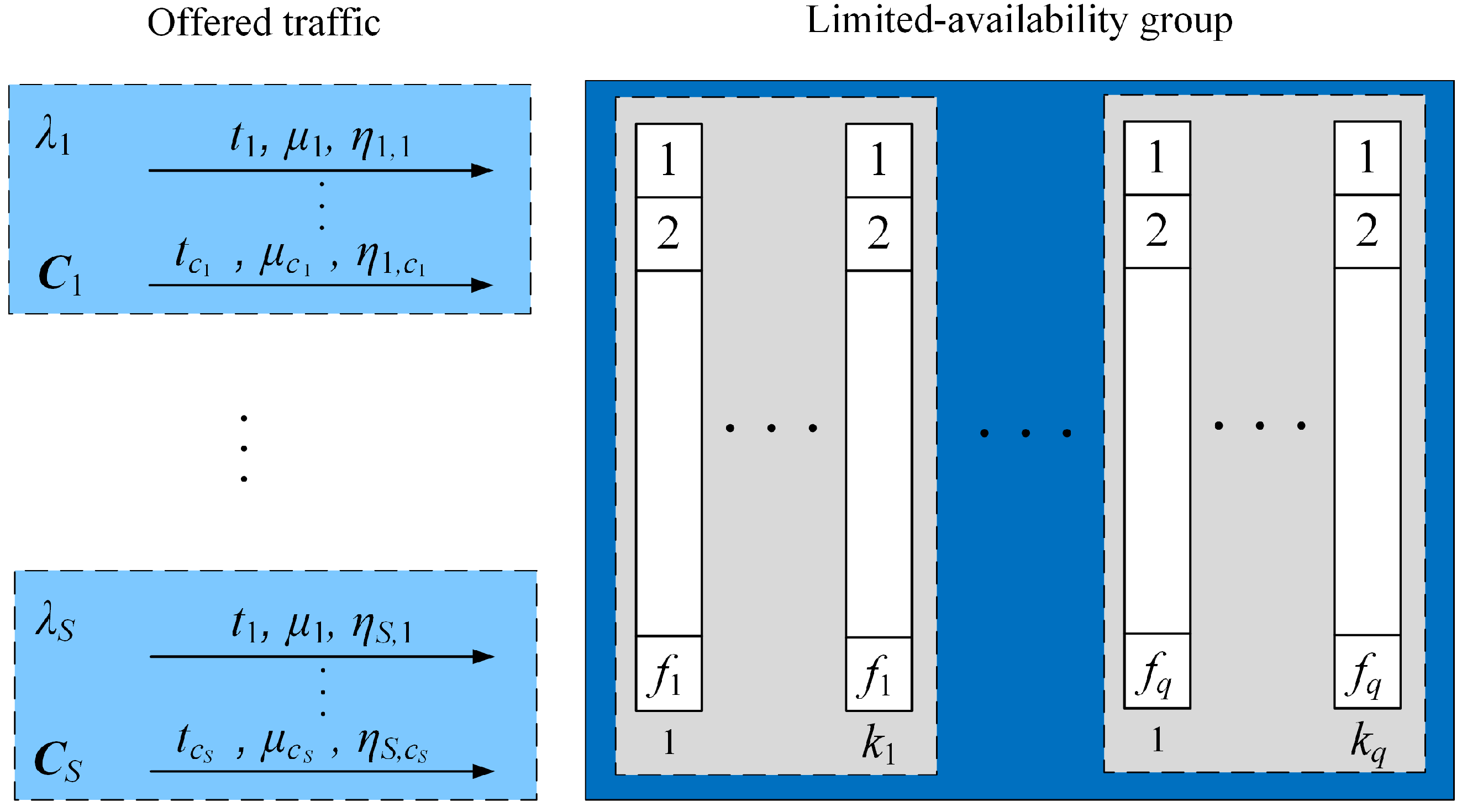

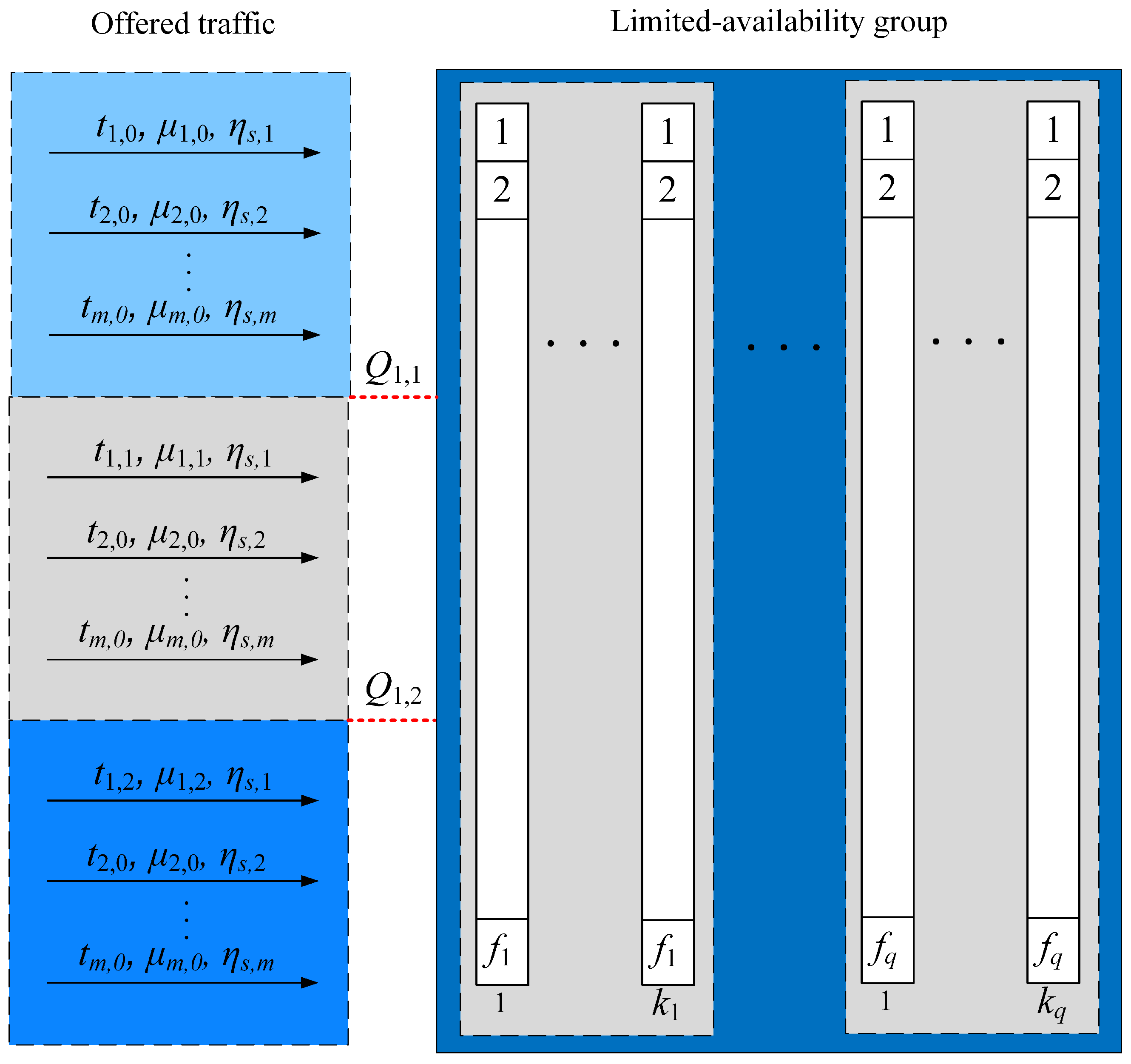
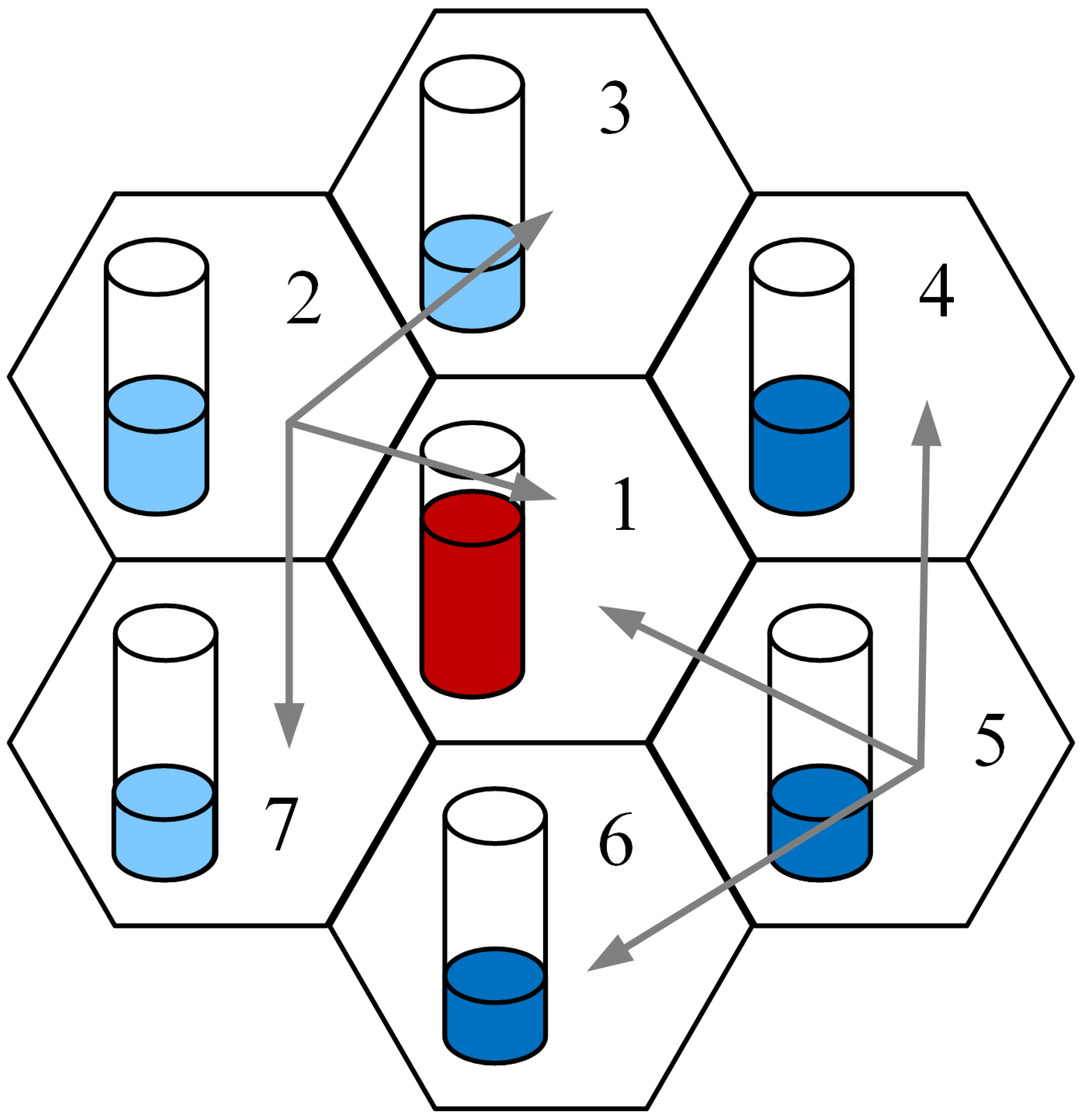




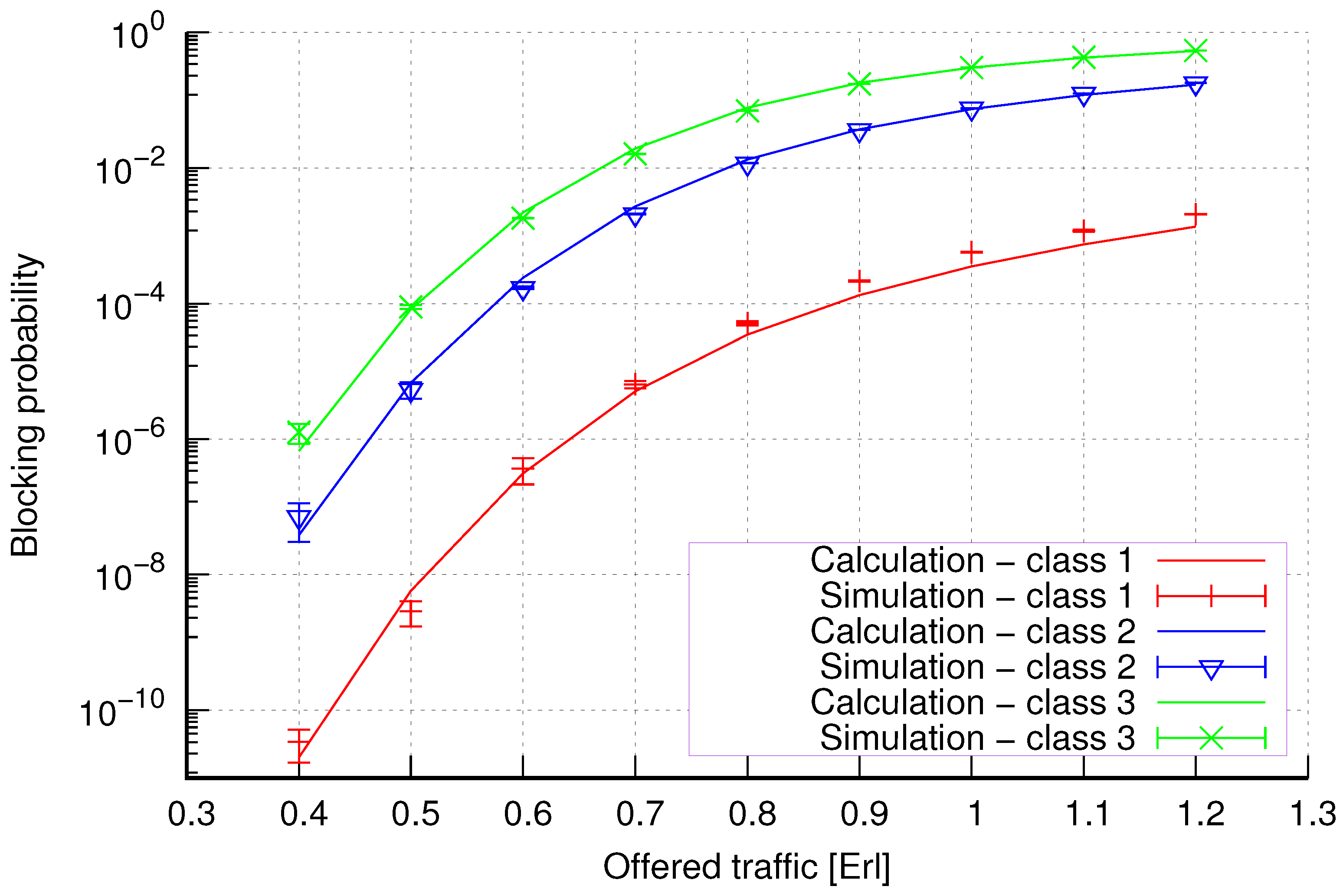
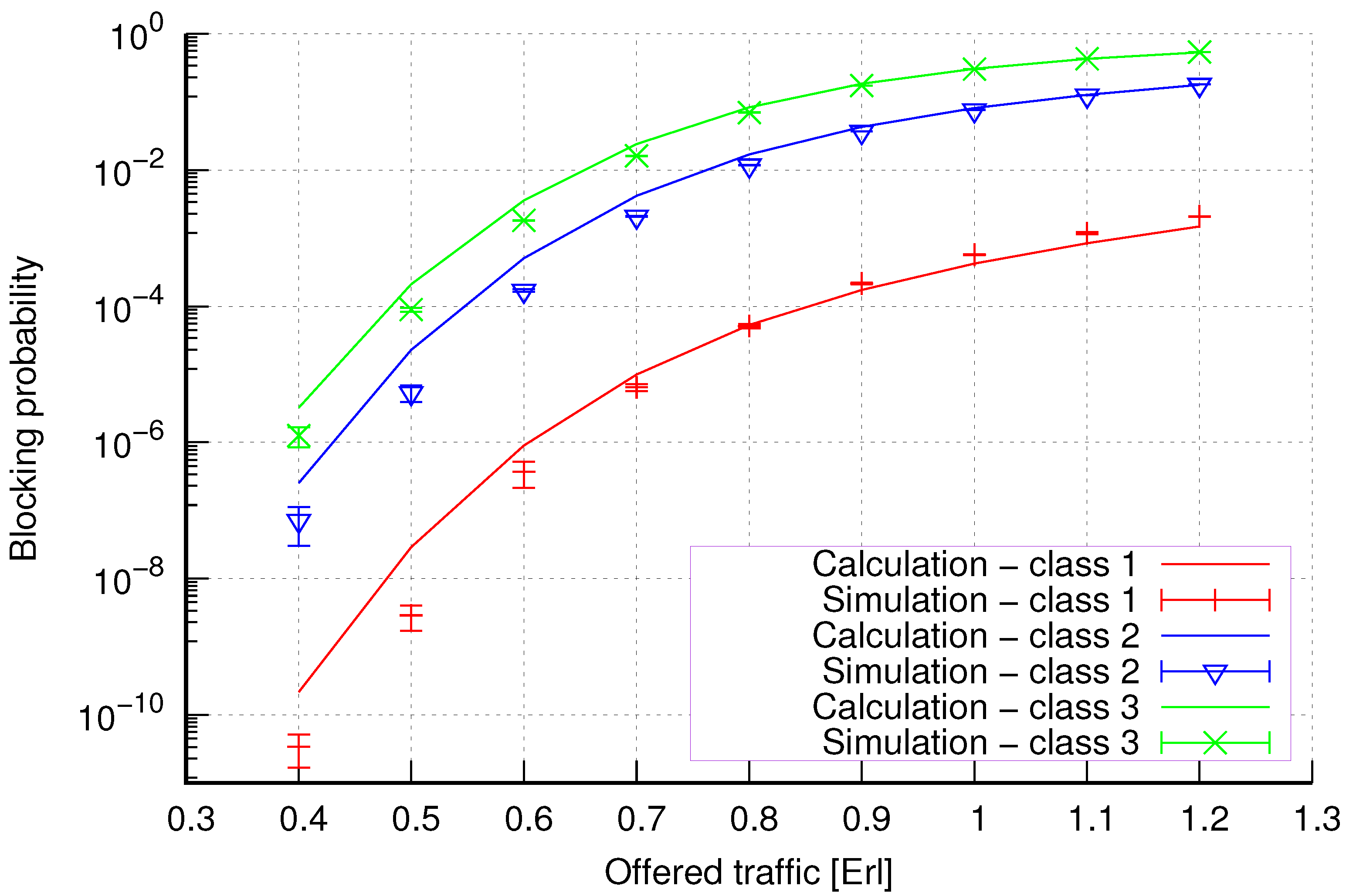


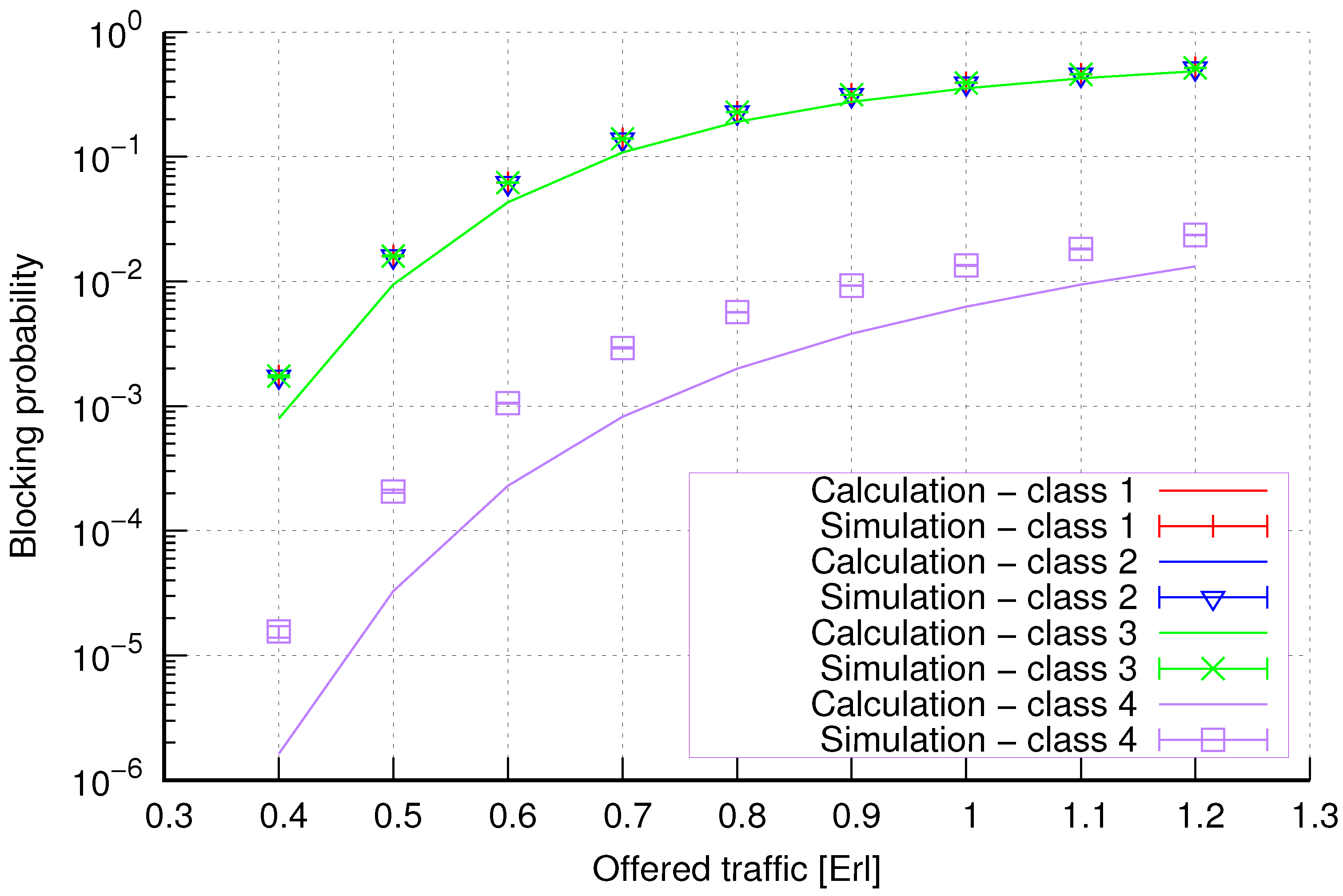
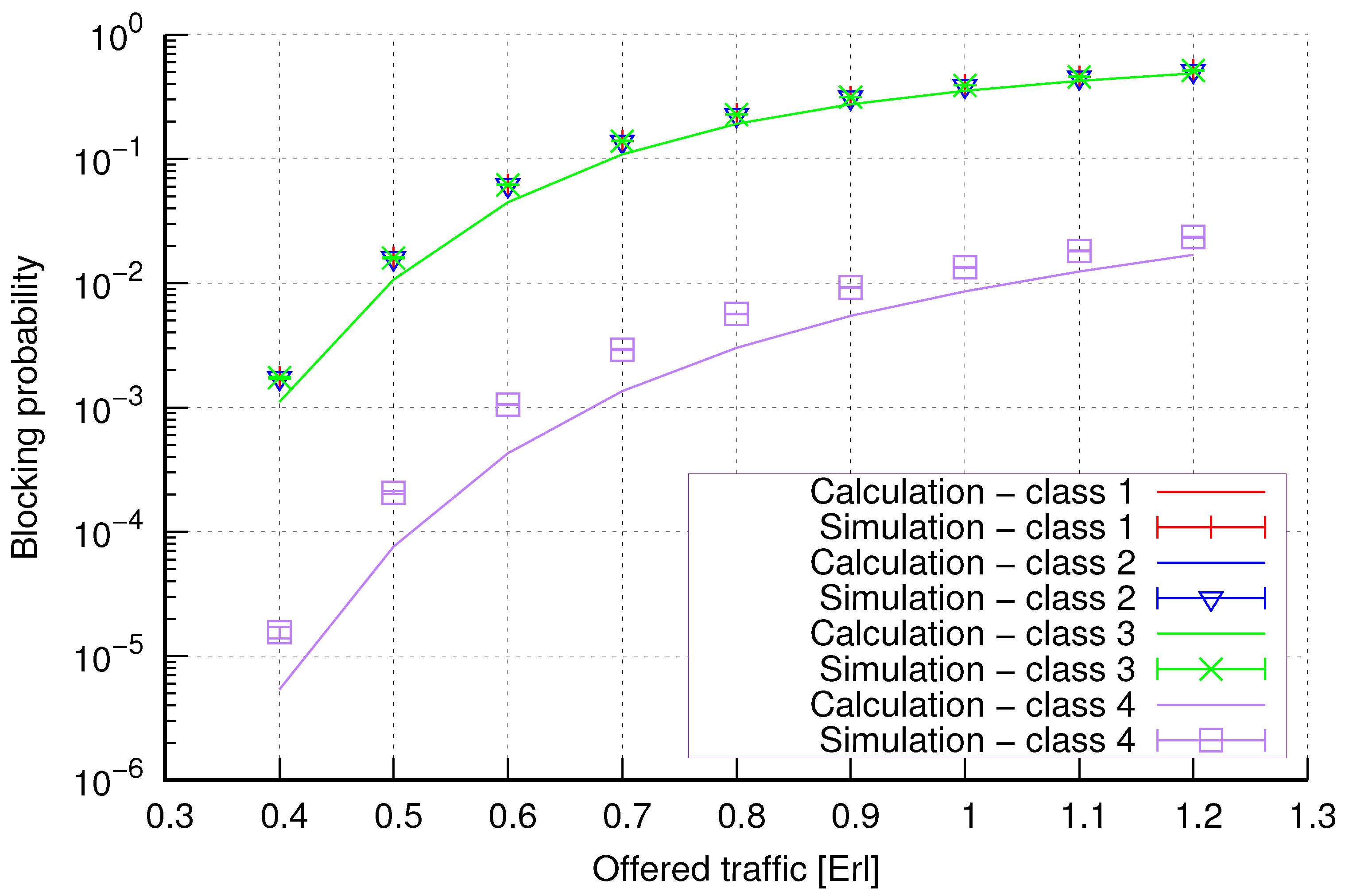
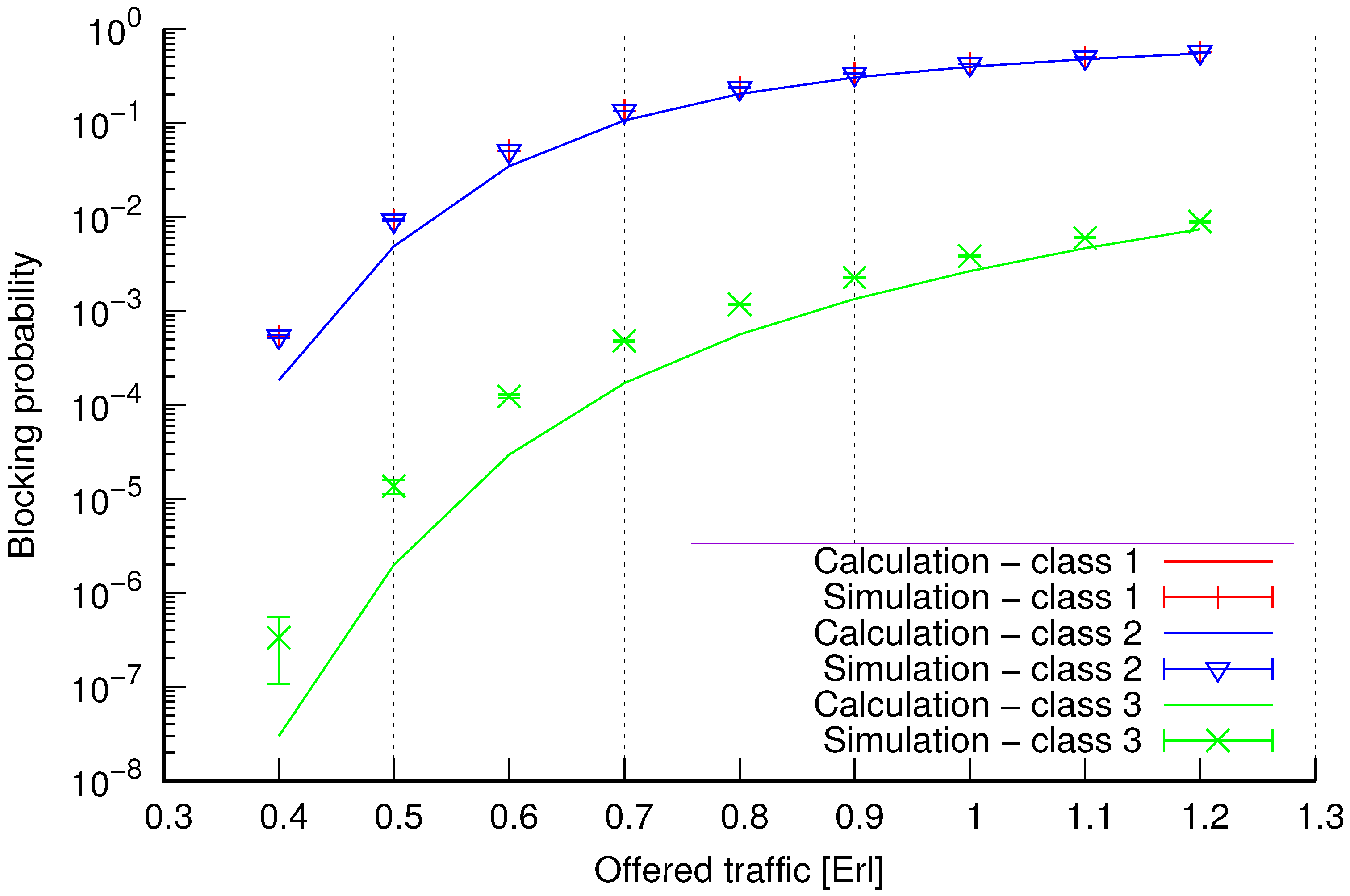
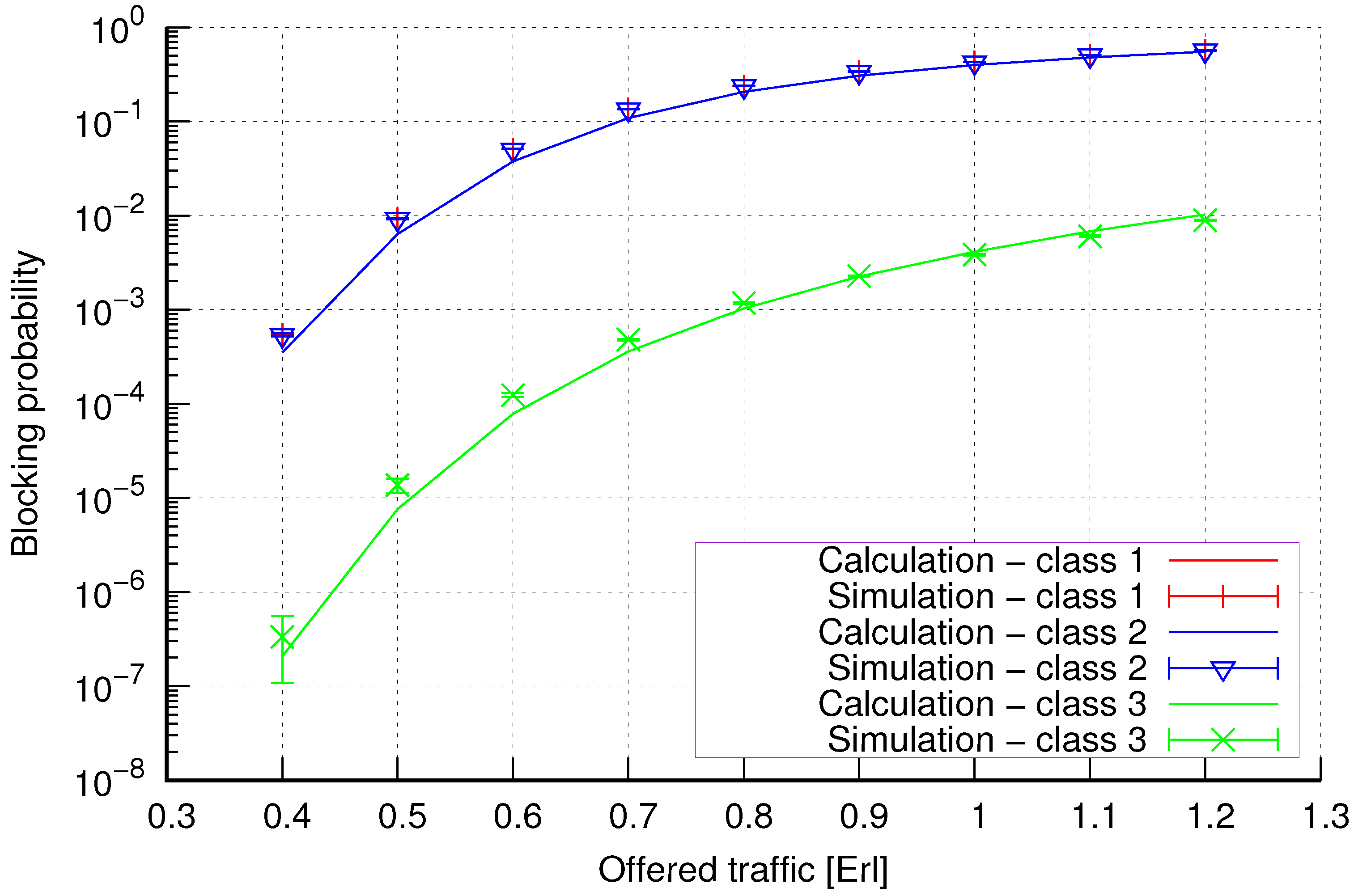
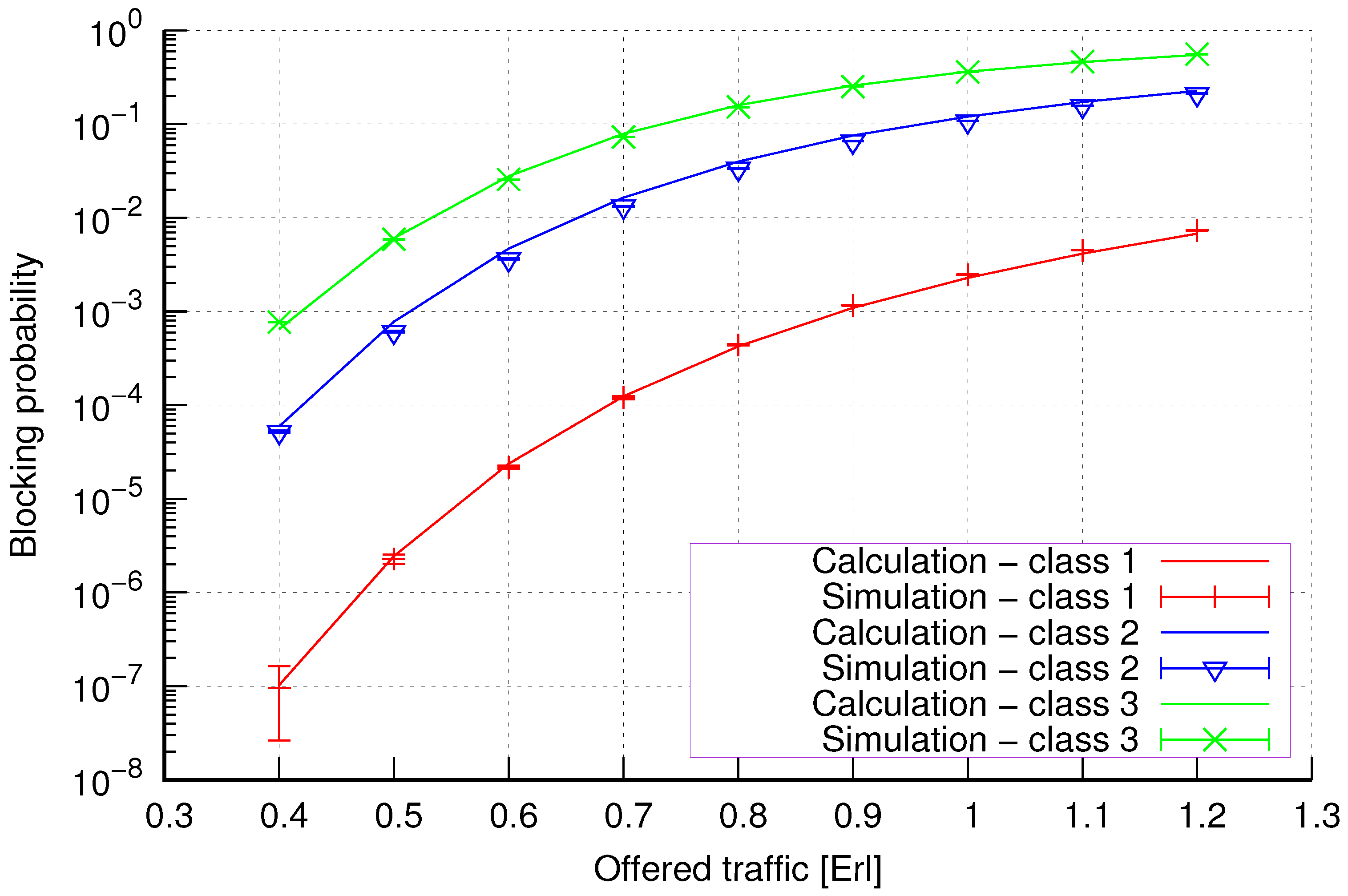
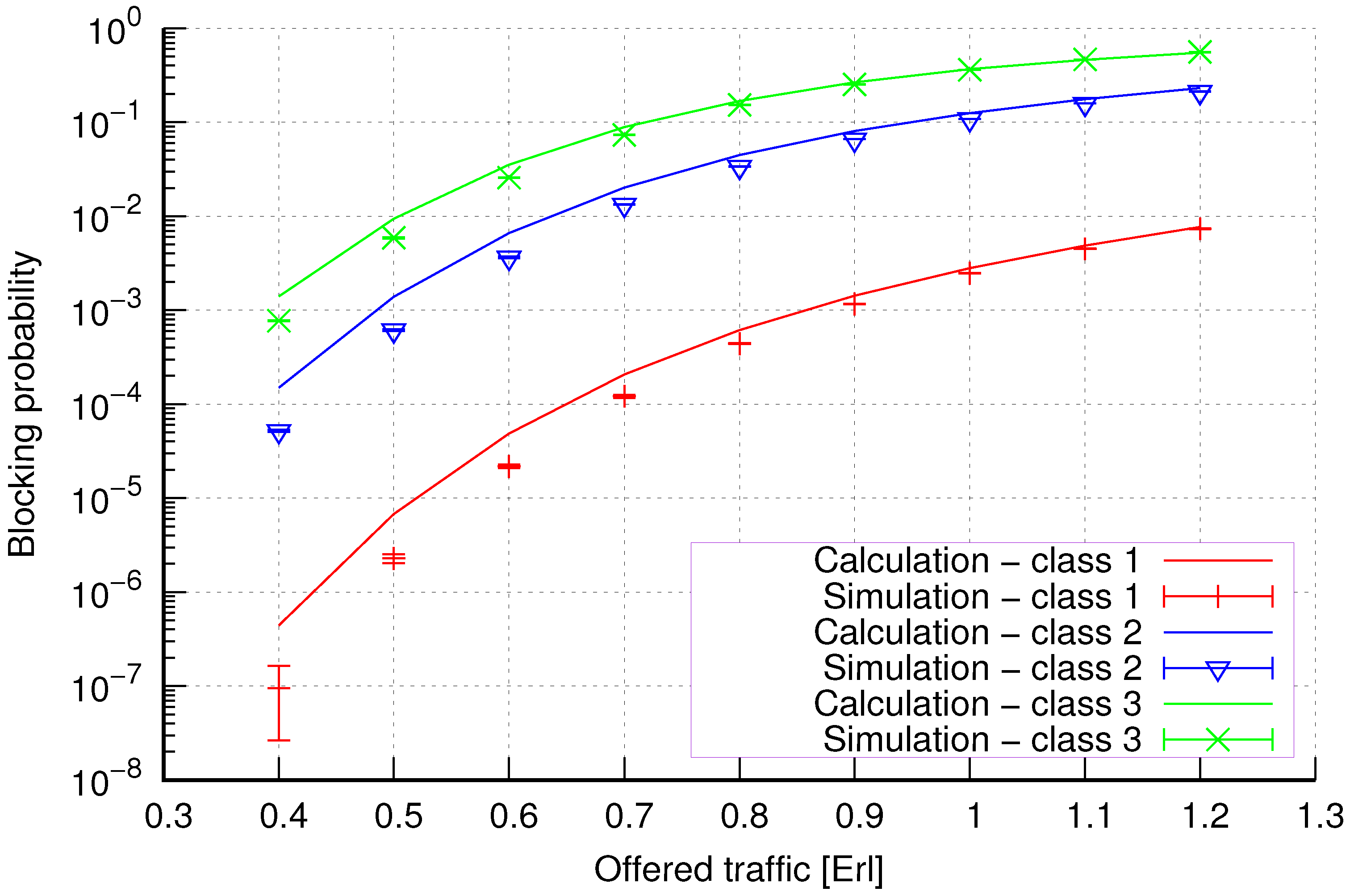
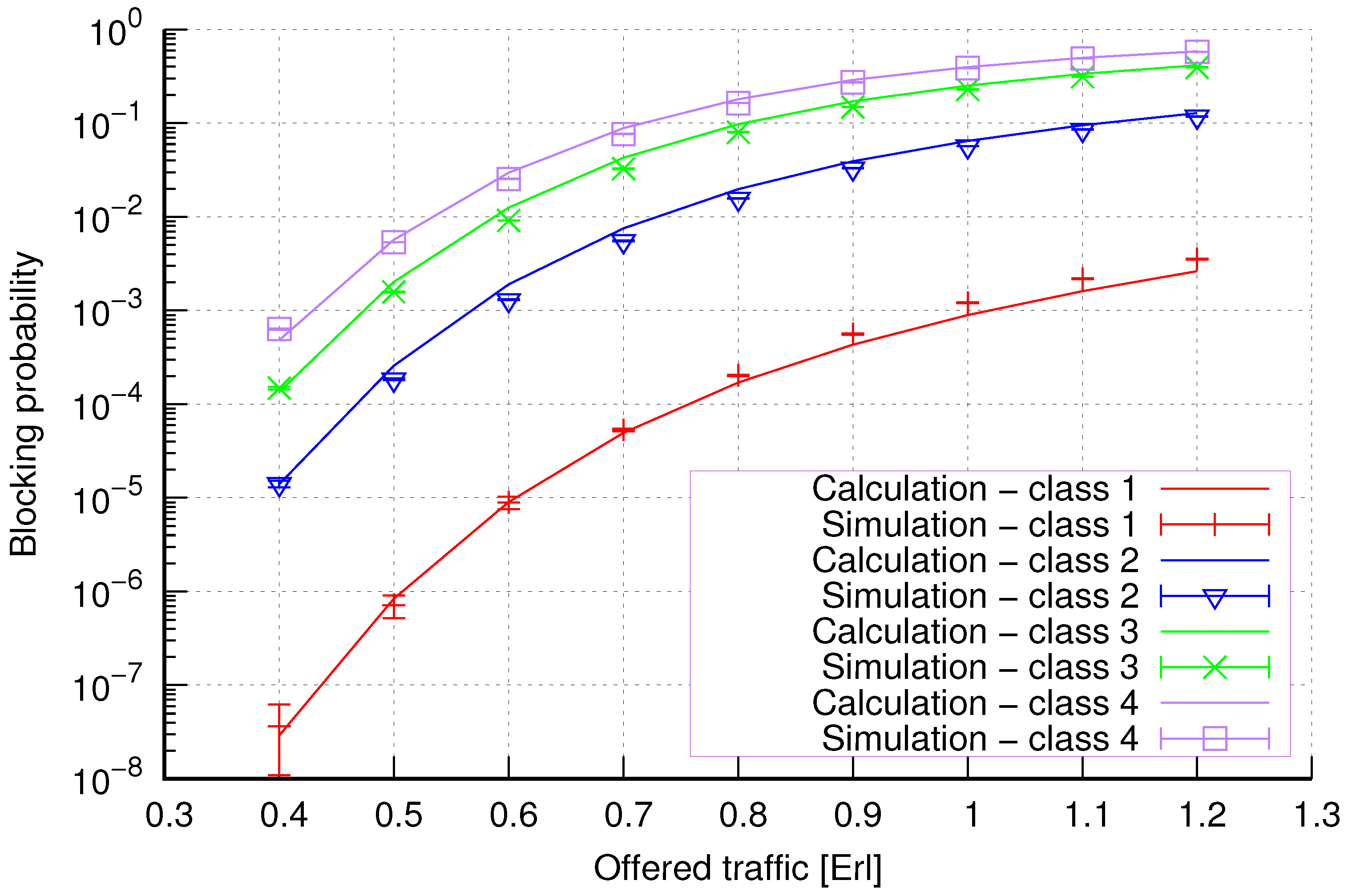



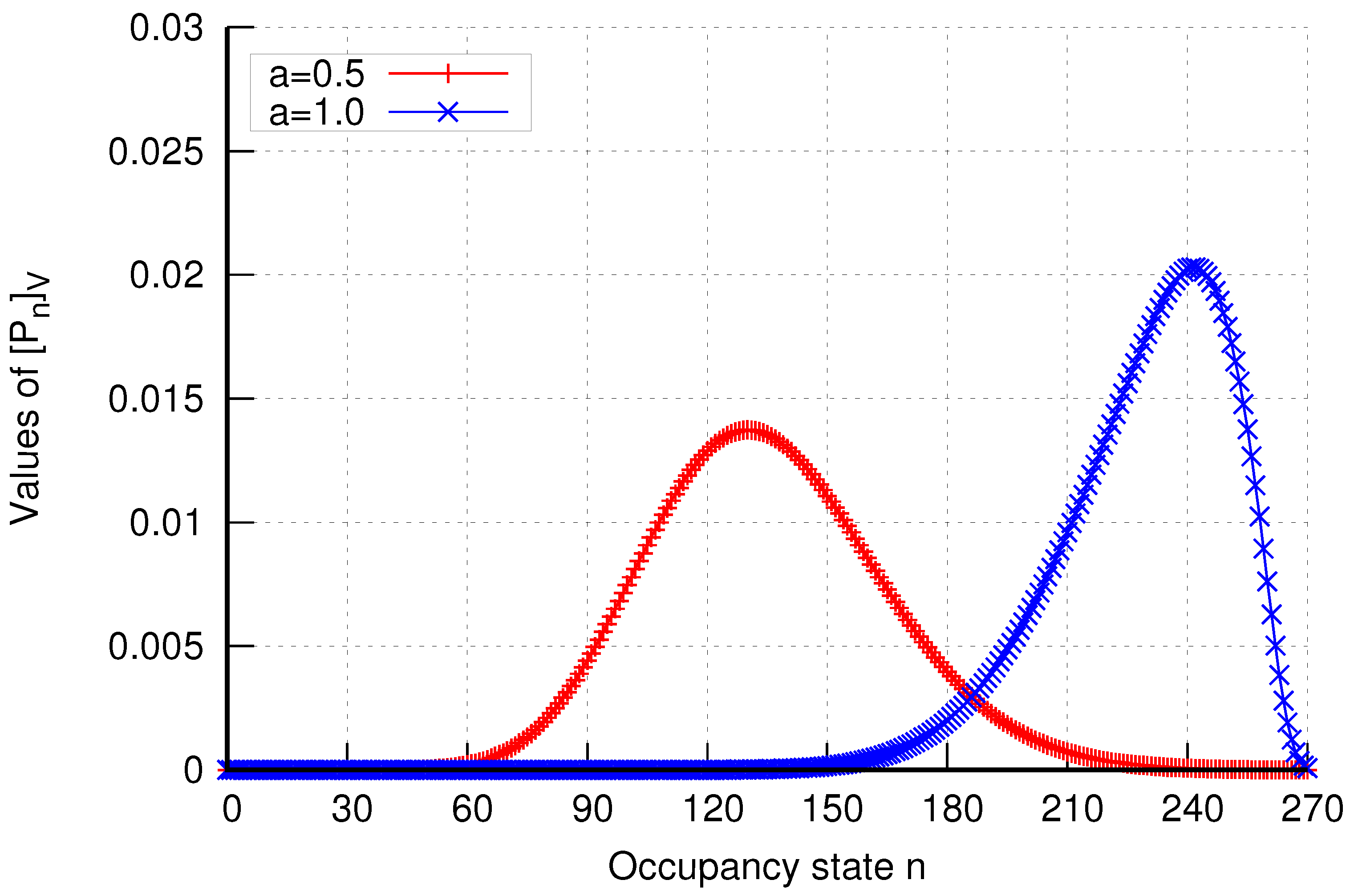
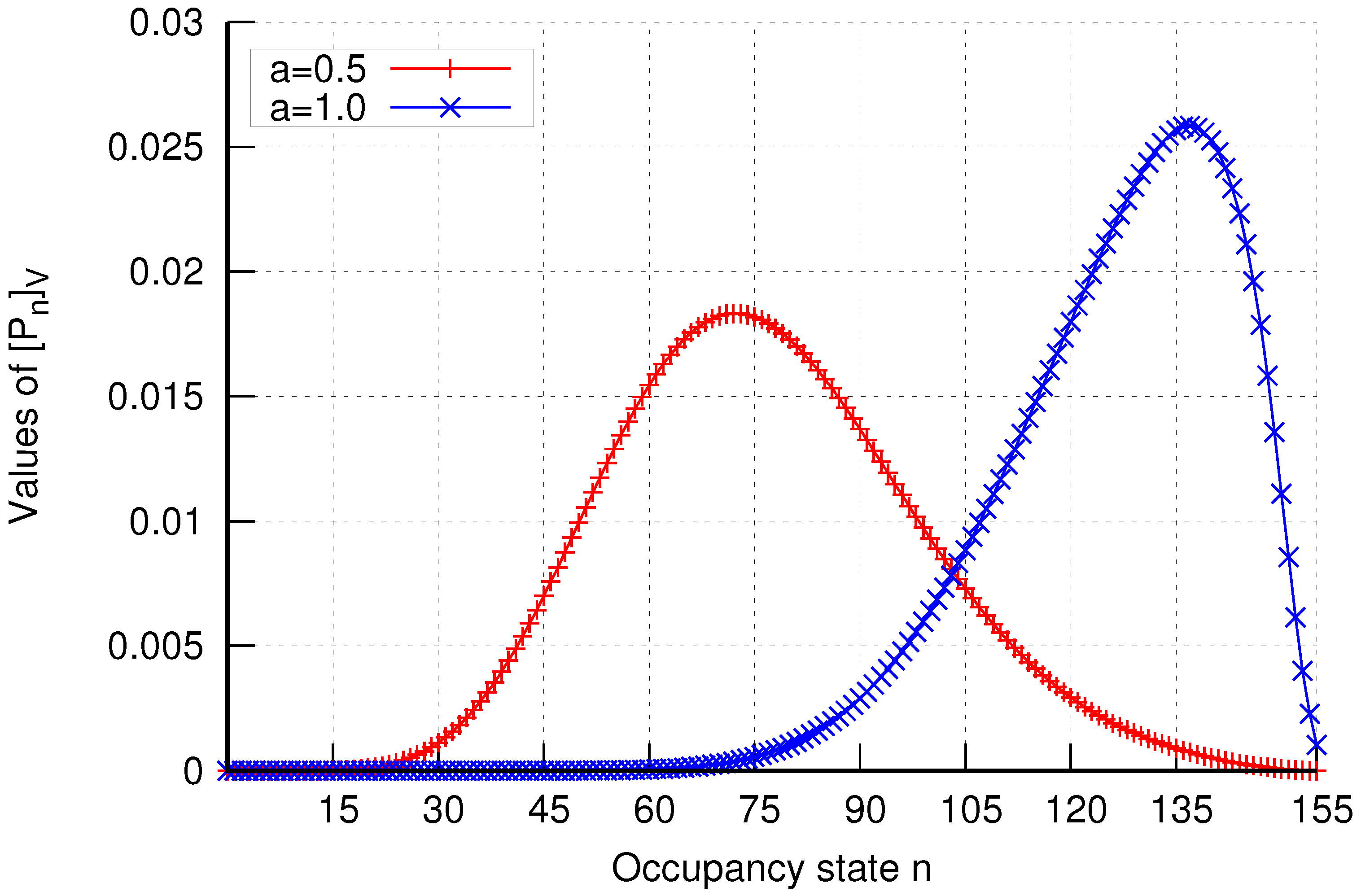
| Simulation | Generated Calls | Lost Calls | ||||
|---|---|---|---|---|---|---|
| No. | Class 1 | Class 2 | Class 3 | Class 1 | Class 2 | Class 3 |
| Erl | ||||||
| 1 | 8,015,163 | 2,002,972 | 1,000,000 | 0 | 4 | 40 |
| 2 | 8,000,646 | 1,999,606 | 1,000,000 | 0 | 4 | 36 |
| 3 | 8,003,612 | 2,001,242 | 1,000,000 | 0 | 6 | 23 |
| 4 | 7,997,956 | 1,998,845 | 1,000,000 | 1 | 6 | 26 |
| 5 | 8,006,855 | 2,003,639 | 1,000,000 | 1 | 2 | 42 |
| Erl | ||||||
| 1 | 8,005,402 | 2,000,097 | 1,000,000 | 3 | 114 | 758 |
| 2 | 8,002,535 | 2,002,714 | 1,000,000 | 1 | 127 | 807 |
| 3 | 7,990,866 | 1,998,619 | 1,000,000 | 4 | 112 | 784 |
| 4 | 8,003,962 | 2,000,647 | 1,000,000 | 4 | 111 | 753 |
| 5 | 8,000,179 | 2,000,384 | 1,000,000 | 5 | 100 | 662 |
| Erl | ||||||
| 1 | 8,016,256 | 2,003,358 | 1,000,000 | 84 | 1414 | 7098 |
| 2 | 8,001,267 | 2,003,524 | 1,000,000 | 86 | 1477 | 7042 |
| 3 | 8,001,351 | 1,999,157 | 1,000,000 | 74 | 1394 | 7159 |
| 4 | 8,001,483 | 1,997,997 | 1,000,000 | 73 | 1516 | 7055 |
| 5 | 7,997,064 | 1,997,529 | 1,000,000 | 70 | 1419 | 7308 |
| Erl | ||||||
| 1 | 8,005,466 | 2,000,655 | 1,000,000 | 668 | 9782 | 35,089 |
| 2 | 7,989,660 | 2,000,098 | 1,000,000 | 735 | 9672 | 35,231 |
| 3 | 7,999,643 | 1,998,351 | 1,000,000 | 570 | 9816 | 35,163 |
| 4 | 7,998,862 | 1,996,429 | 1,000,000 | 797 | 9669 | 35,169 |
| 5 | 8,011,478 | 2,000,240 | 1,000,000 | 643 | 9626 | 35,155 |
| Erl | ||||||
| 1 | 8,016,212 | 2,003,034 | 1,000,000 | 3361 | 37,033 | 103,651 |
| 2 | 8,000,809 | 1,999,740 | 1,000,000 | 3304 | 37,380 | 104,169 |
| 3 | 8,007,225 | 2,002,980 | 1,000,000 | 3351 | 36,991 | 103,743 |
| 4 | 7,989,013 | 1,998,646 | 1,000,000 | 3312 | 36,748 | 103,690 |
| 5 | 7,990,865 | 1,997,921 | 1,000,000 | 3348 | 37,193 | 104,141 |
| Erl | ||||||
| 1 | 8,015,925 | 2,002,674 | 1,000,000 | 10,312 | 91,261 | 208,430 |
| 2 | 7,996,733 | 2,000,352 | 1,000,000 | 10,123 | 90,897 | 209,014 |
| 3 | 8,004,606 | 1,998,289 | 1,000,000 | 10,334 | 90,849 | 209,203 |
| 4 | 7,993,835 | 2,000,331 | 1,000,000 | 10,156 | 90,849 | 209,182 |
| 5 | 7,993,240 | 1,997,134 | 1,000,000 | 9995 | 90,761 | 209,349 |
| Erl | ||||||
| 1 | 8,006,435 | 2,000,442 | 1,000,000 | 22341 | 166982 | 329437 |
| 2 | 8,007,892 | 2,000,203 | 1,000,000 | 22,911 | 167,469 | 329,535 |
| 3 | 8,014,370 | 2,003,343 | 1,000,000 | 22,922 | 168,464 | 328,232 |
| 4 | 7,999,943 | 2,001,715 | 1,000,000 | 22,415 | 166,966 | 329,028 |
| 5 | 7,996,504 | 1,999,651 | 1,000,000 | 22,775 | 167,821 | 329,304 |
| Erl | ||||||
| 1 | 8,018,878 | 2,003,590 | 1,000,000 | 40,424 | 261,294 | 443,488 |
| 2 | 7,989,703 | 1,997,843 | 1,000,000 | 41,342 | 261,824 | 445,539 |
| 3 | 8,005,807 | 2,002,445 | 1,000,000 | 41,182 | 260,772 | 443,122 |
| 4 | 7,996,982 | 2,000,633 | 1,000,000 | 41,035 | 260,411 | 444,261 |
| 5 | 8,009,529 | 2,001,840 | 1,000,000 | 40,820 | 261,568 | 444,342 |
| Erl | ||||||
| 1 | 8,019,782 | 2,003,955 | 1,000,000 | 65,725 | 363,295 | 545,466 |
| 2 | 8,006,984 | 2,003,003 | 1,000,000 | 65,844 | 363,668 | 547,309 |
| 3 | 8,008,821 | 2,000,908 | 1,000,000 | 64,933 | 362,008 | 545,762 |
| 4 | 8,003,306 | 2,001,821 | 1,000,000 | 65,496 | 361,843 | 545,553 |
| 5 | 8,010,187 | 2,001,188 | 1,000,000 | 65,035 | 363,342 | 546,434 |
Disclaimer/Publisher’s Note: The statements, opinions and data contained in all publications are solely those of the individual author(s) and contributor(s) and not of MDPI and/or the editor(s). MDPI and/or the editor(s) disclaim responsibility for any injury to people or property resulting from any ideas, methods, instructions or products referred to in the content. |
© 2024 by the authors. Licensee MDPI, Basel, Switzerland. This article is an open access article distributed under the terms and conditions of the Creative Commons Attribution (CC BY) license (https://creativecommons.org/licenses/by/4.0/).
Share and Cite
Głąbowski, M.; Sobieraj, M.; Stasiak, M. Analytical Model of the Connection Handoff in 5G Mobile Networks with Call Admission Control Mechanisms. Sensors 2024, 24, 697. https://doi.org/10.3390/s24020697
Głąbowski M, Sobieraj M, Stasiak M. Analytical Model of the Connection Handoff in 5G Mobile Networks with Call Admission Control Mechanisms. Sensors. 2024; 24(2):697. https://doi.org/10.3390/s24020697
Chicago/Turabian StyleGłąbowski, Mariusz, Maciej Sobieraj, and Maciej Stasiak. 2024. "Analytical Model of the Connection Handoff in 5G Mobile Networks with Call Admission Control Mechanisms" Sensors 24, no. 2: 697. https://doi.org/10.3390/s24020697
APA StyleGłąbowski, M., Sobieraj, M., & Stasiak, M. (2024). Analytical Model of the Connection Handoff in 5G Mobile Networks with Call Admission Control Mechanisms. Sensors, 24(2), 697. https://doi.org/10.3390/s24020697








